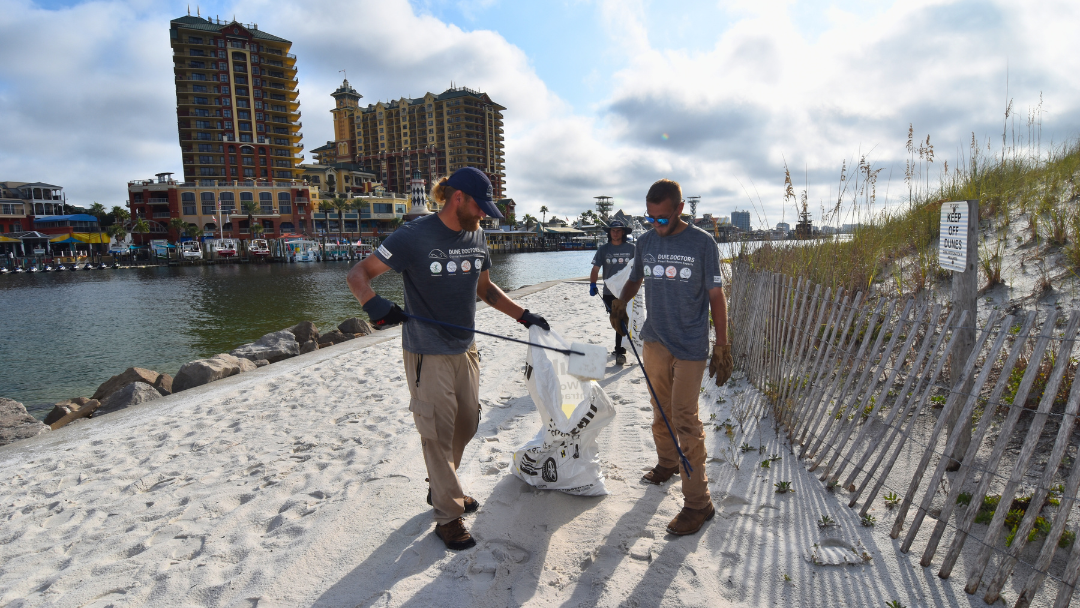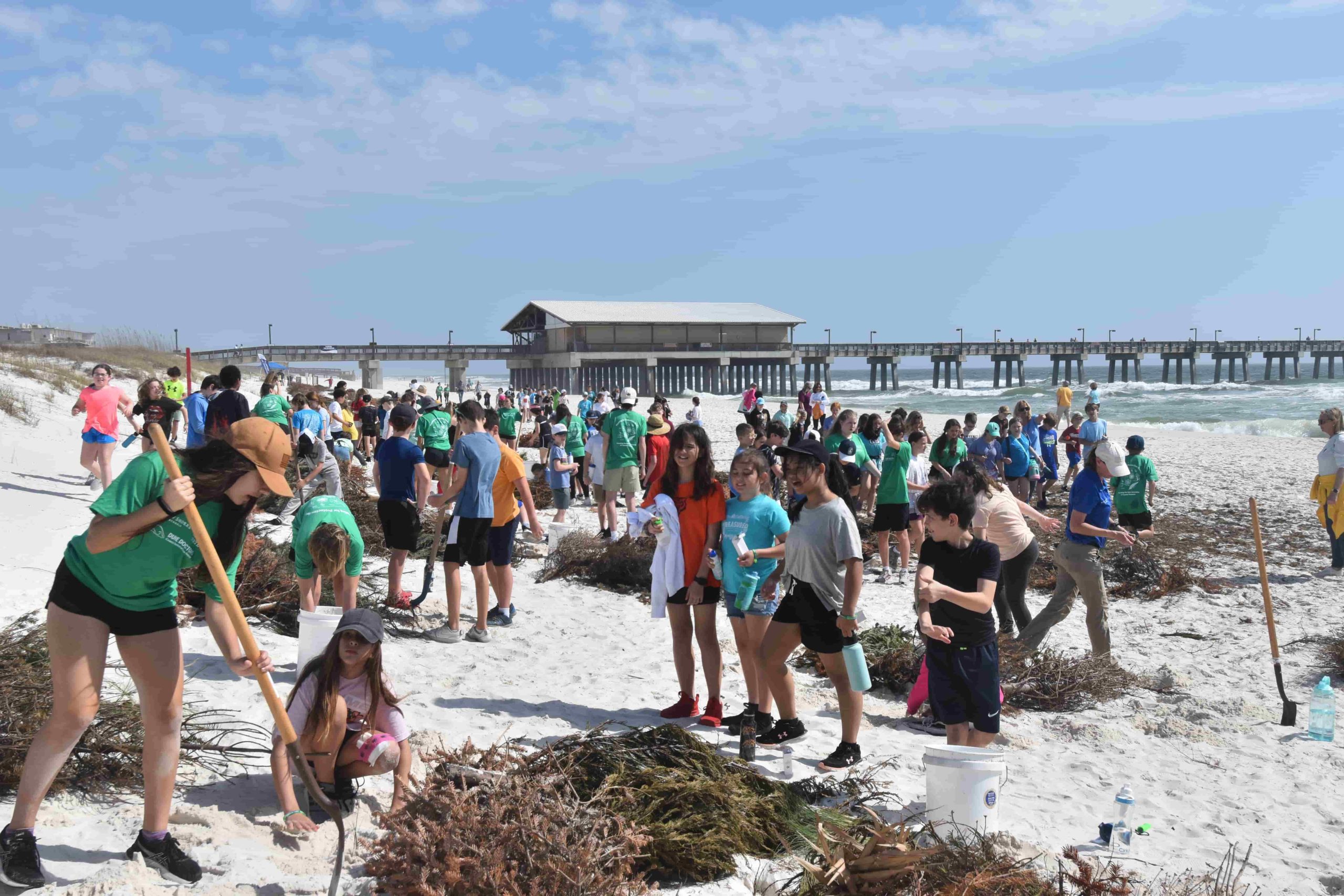An introduction to 9 native plants that grow on the pioneer and primary dunes of the Gulf Coast.
Article Highlight: Native vegetation help initiate, develop, stabilize, and enhance coastal dunes. Proactive coastal homeowners that invest in native coastal plants reap the benefit of a synergistic, healthy dune system.
Key Takeaway: Each coastal plant serves an ecological function. Therefore, it is critical to use a diverse sampling of native vegetation when restoring dune ecosystems.
Application: Have Dune Doctors acquire and install dune-stabilizing vegetation on your property. Our method guarantees that 95% of plants will be thriving at the 3-month mark.
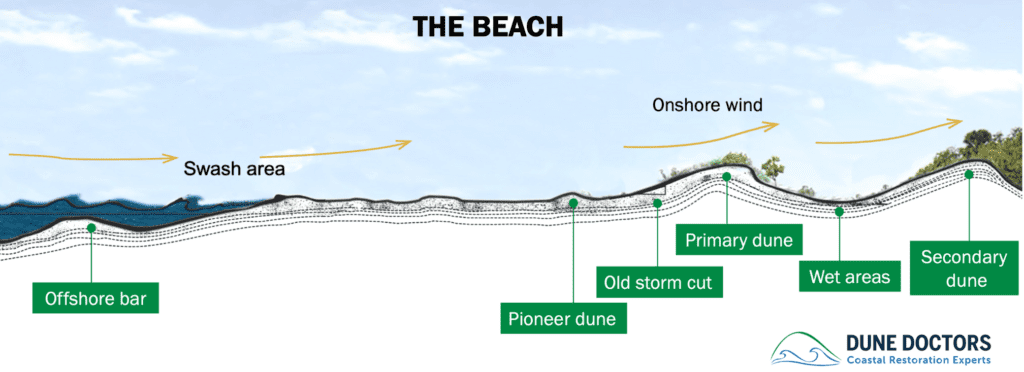
The Gulf Coast’s plant life is varied and dynamic. Along high-energy beaches with pounding wave action, vegetation typically does not spread seaward into the swash zone (where waves run up the beach). The swash zone is the boundary between land and water. Landward of the swash zone lies the rest of the beach and the pioneer dune. Vegetation that initiates the pioneer dune (the developing dune closest to the water) are well-adapted for periods of temporary flooding and can survive being submerged by abnormally high tides and floods. As dune-building grasses grow seaward, sand accumulates around them resulting in the initiation of the pioneer dune. As pioneer dunes increase in height, they will grow and start to connect with other pioneer dunes, eventually forming a new primary dune (the established dune closest to the water).
Mature dunes (secondary, tertiary, etc.) lie behind the primary dune and hold a greater plant diversity because they face less environmental stressors (salt spray, temporary inundation, sand blasts). As these dunes accumulate more organic material, woody vegetation will colonize them, developing into a scrub zone and, eventually, a maritime forest. Given the variety of plants that grow throughout these unique coastal areas, appropriate plant selection and installation are critical. The vegetation needed to restore a primary dune is different than what would be used to restore the scrub zone.
Dune Doctors focuses on helping communities achieve sustainable coastal resiliency by enhancing the protective role coastal dunes play in limiting the impact of destructive storm surge. Therefore, we focus on addressing erosion-prone areas throughout the primary dune and on initiating the development of sand berms. Located seaward of the primary dune, sand berms are continuous sand barriers that accumulate sand evenly in height and distribution across the width of the property. We initiate sand berms with the combined use of sand fences & native vegetation. In both cases, our Coastal Restoration Experts work with native vegetation that typically grows on the pioneer and primary dune. Our plant selections are custom-grown and help accelerate sand accretion (the build-up of sand) and stabilize dune systems. Below are the nine coastal plants that our Coastal Restoration Experts routinely work with.
THE GRASSES – DUNE INITIATION & STABILIZATION
When exploring the Gulf Coast, you will typically encounter 3 kinds of plants that propagate (spread) towards the sea: the Sea Oat, Panic Grass and Saltmeadow Cordgrass. As pioneer plants, they have adapted to the extremes of the coastal environment and can be considered first responders because they are the first plants to colonize the beach after storm damage. They are responsible for the development of pioneer dunes, in addition to helping limit coastal erosion.
Sea Oats – Uniola Paniculata
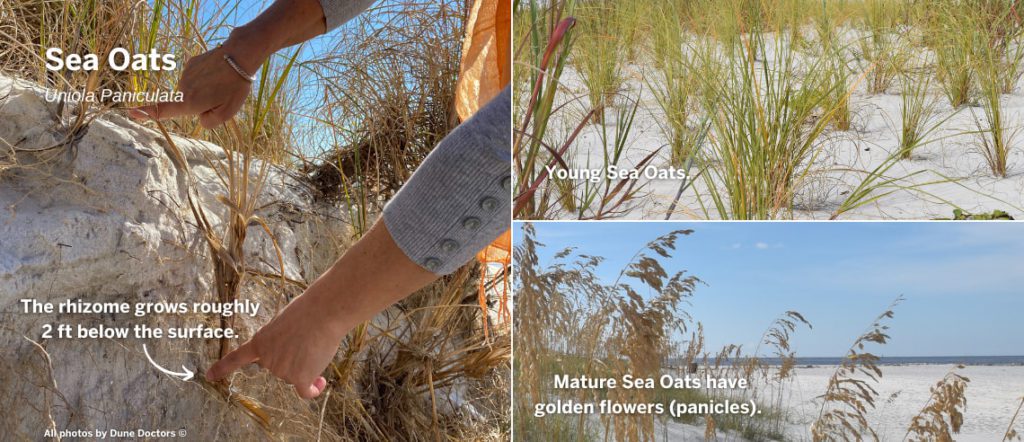
Sea Oats are the primary dune-stabilizing plant located along the Gulf Coast. This plant can survive its nutrient-poor environment because it gains mineral nutrients from the sand, salt spray, and its decaying matter. According to Carrie Stevenson the Coastal Sustainability Agent for the UF Escambia County Extension Office, Sea Oats’ roots can grow roughly 40ft and extend in all directions in search of the scarce nutrients and water buried within the core of the dune (8). This root growth functions as a complex web that anchors the sand in place. Sea Oats also propagate seaward via rhizomes (underground horizontal stems) that sprout new plants.
Their seeds are a source of food for beach-nesting populations including birds, crabs and beach mice. Its leaves grow from the meristem located at the plants’ crown (where the stem meets the root system). If a footstep crushes the meristem, the plant will die, and it can no longer fulfill its ecological function of holding sand in place. Signs that say “Please Stay off the Dunes” are in place to protect plants from foot traffic.
Panic Grass – Panicum amarum
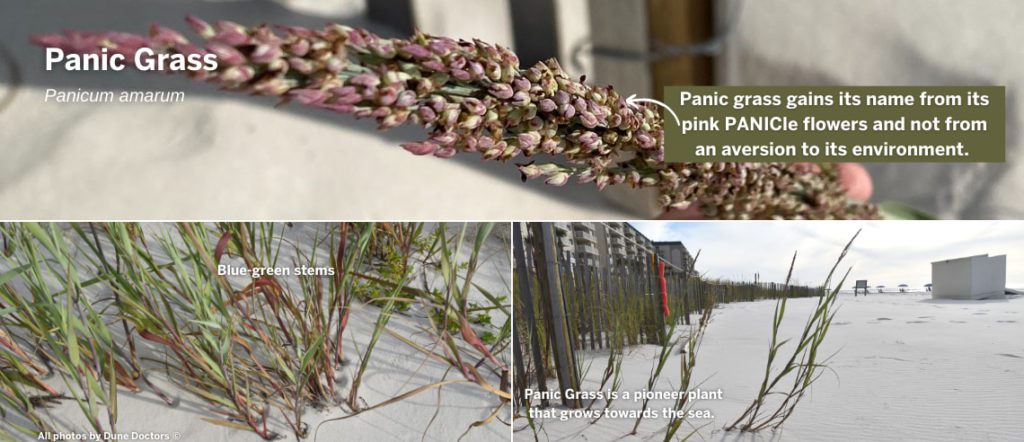
Growing alongside Sea Oats in the pioneer and primary dune, the blue-ish green Panic Grass is another plant that stabilizes and builds coastal dunes. This plant mainly propagates seaward via nodes along its stem and is clump-forming (tends to grow in groups). The common name “Panic” grass does not originate from the plants’ aversion to its challenging environment but its seed-bearing PANICles (a loose branching cluster of flowers).
Research conducted by Rusty J. Rodrigues revealed how this grass is able to survive the stress imposed by salt spray and dry conditions. His testing demonstrated that Panic Grass holds a symbiotic (a mutually beneficial relationship) relationship with water-absorbing fungi present on its roots resulting in a more “efficient use of water:” drought tolerance (5). Blair Witherington describes this relationship as follows, “the water-absorbing fungi (mychorrhizae) send out microscopic tendrils (mycelia), thinner than the tiniest root, that vastly increase the cooperative (plant’s and fungi’s) surface area for absorbing water and nutrients. (10)”
Saltmeadow Cordgrass – Spartina Patens
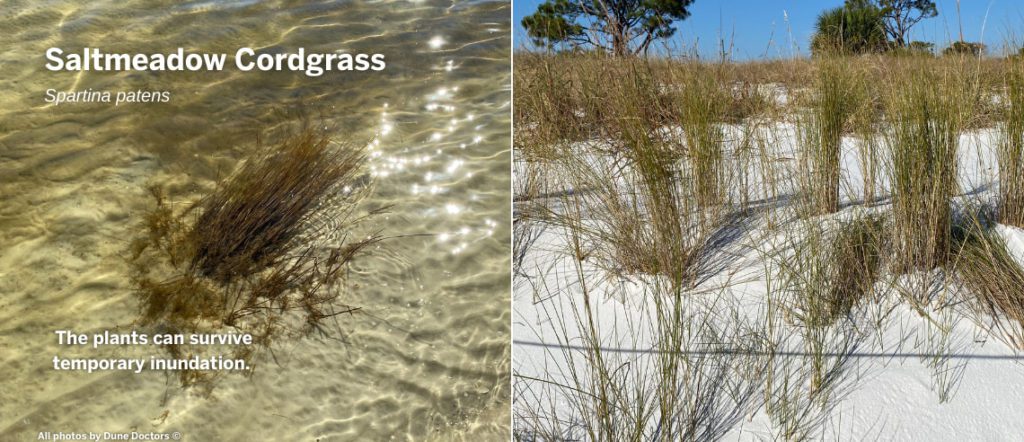
Saltmeadow Cordgrass is a tufted grass native to the Gulf and Atlantic Coast. The plant can survive being temporarily submerged in saltwater and is, therefore, typically the most seaward-growing plant. According to the United States Environmental Protection Agency, the plant has adapted to this environment by secreting salt from glands in its leaves (6).
The plant exhibits a rhizomatous clumping growth pattern that results in dense tufts of grass and helps absorb some of the destructive energy brought forth by waves. For this reason, Dune Doctors installs this plant in tidal marsh restorations projects as well as at the base of developing dunes along the coast. Saltmeadow Cordgrass helps limit erosion by stabilizing sand and absorbing some wave energy before it reaches land. The plant’s seeds also provides food for beach-nesting populations and algae that grows on the leaf’s surface provides food for grazers like the periwinkle snail.
GROUND COVERS – SAND RETENTION
The ground covers exhibit sprawling growth along the surface of the dune and retain sand in place allowing for the dune to increase in height.
Beach Elder Iva imbricata
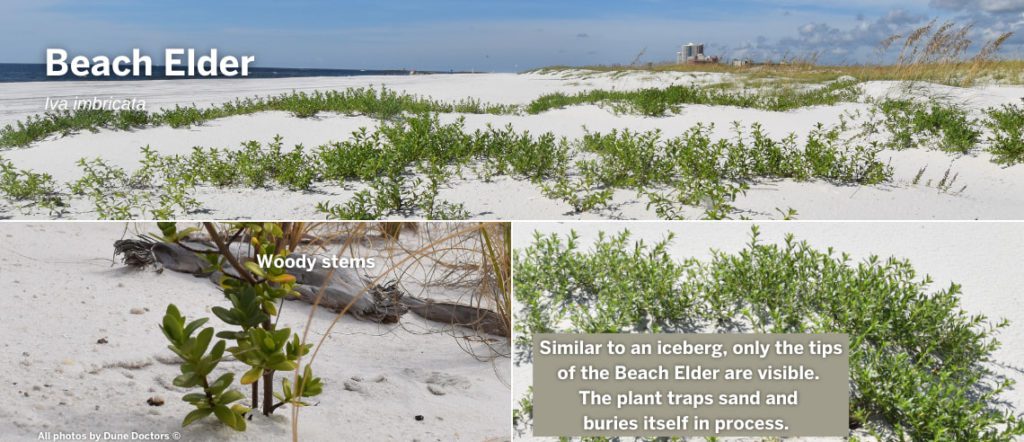
Beach Elder plays a critical role in restoring, stabilizing, and forming coastal dunes because of its ability to trap sand. The succulent, shrub-like perennial woody plant can reach heights of 1 to 4 ft and widths of up to 6 ft. As moving sand particles collide with the stems and accumulate in place, the portion of the stem below the surface responds to being buried by producing roots. Typically, the Beach Elder grows on the flat of the beach and helps initiate pioneer dunes.
White Morning Glory Ipomoea imperati and the Red Morning Glory (Railroad Vine) Ipomoea pes-caprae

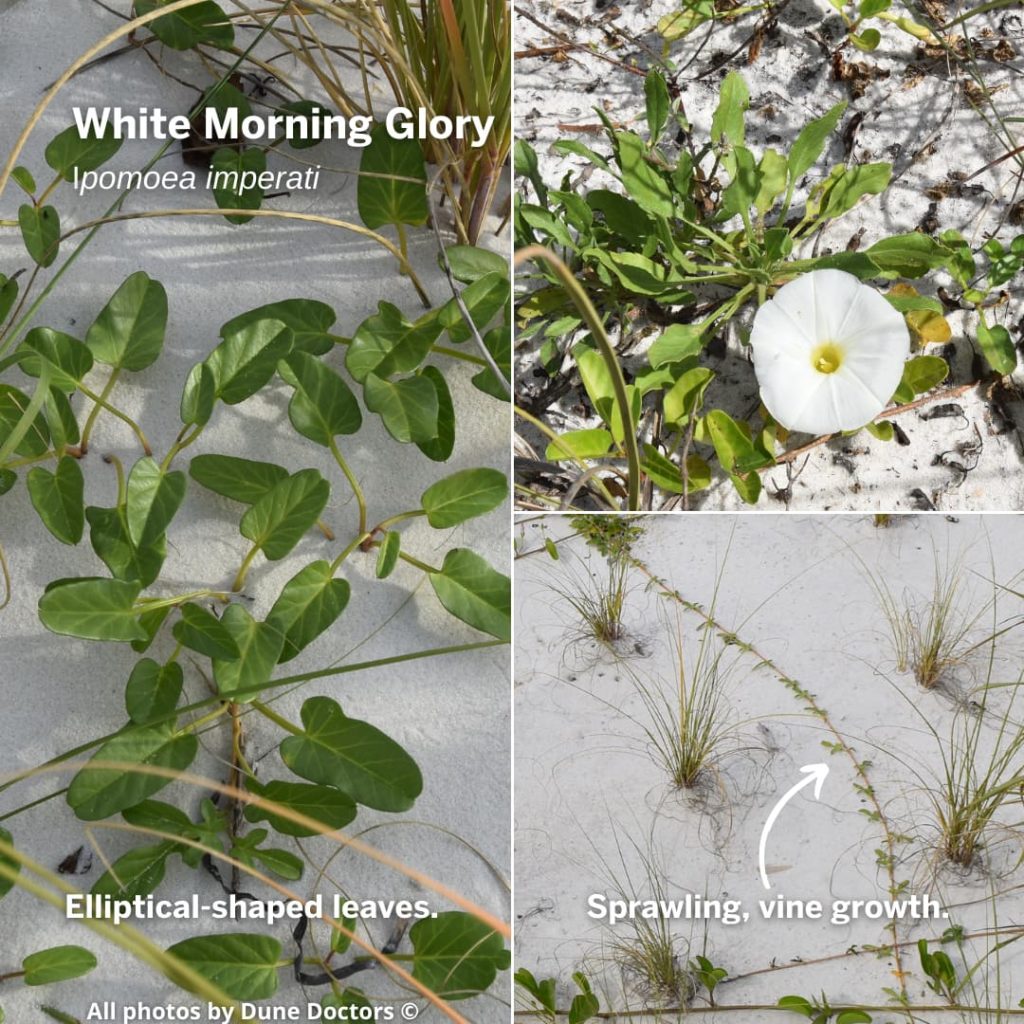
Two Ipomoea species grow along the Gulf Coast, the Beach Morning-Glory and the Railroad Vine. Both are stoloniferous and grow horizontal stems that can grow upwards of 30ft, covering the dune’s surface. The plants play a critical role in the dune ecosystem by stabilizing sand and providing seeds for several types of wildlife, including the endangered beach mouse.
The difference between both ground covers is the shape and size of their leaves, the thickness of their stem, and the color of their flowers. White Morning Glory produces white flowers and has a velvety leaf that has three lobes. Whereas the Railroad Vine has a significantly thicker stem, purple flowers, and kidney-shaped leaves. Both plants tend to die back during the winter and return in the spring. However, they can both flower year-round depending on where they are located.
Sea Purslane Sesuvium portulacastrum
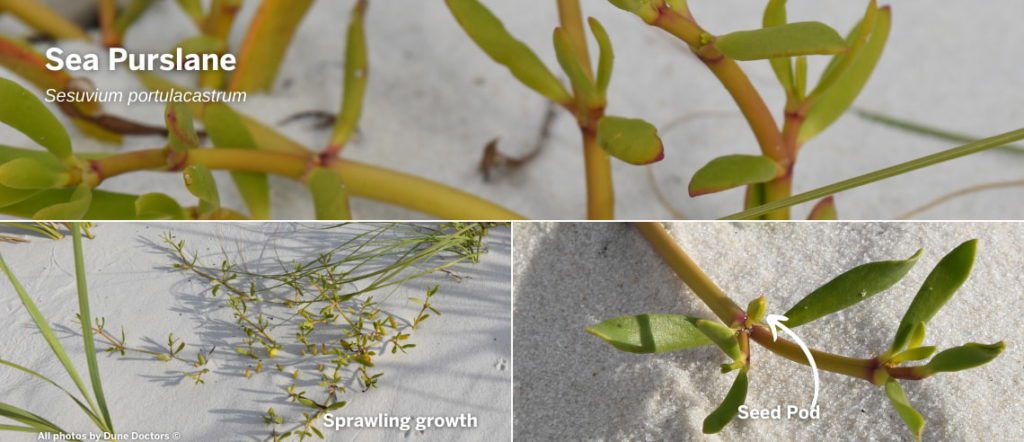
Sea Purslane, another ground cover, is a succulent that develops from the primary dune towards the upper beach. Similar to the other ground covers, it helps limit the movement of sand along the surface of the dune. The sea purslane blooms year-round, but their starlike flowers do not have petals, only five purple sepals (the portion of the flower that typically encloses petals). The Sea Purslane’s value extends beyond the dunes! The plant is consumed worldwide and has the common culinary name: Sea Pickle.
FLOWERS – VIBRANT FOOD SOURCES
The dunes also host a colorful arrangement of flowers whose seeds feed beach nesting birds, mammals, crustaceans, and insects. In addition to fulfilling this critical ecological function, these flowers also add color, increasing the aesthetic value of the dune. These salt-tolerant beauties can grow on the seaward facing slope of the primary dune.
Dune Sunflower – Helianthus debilis & the Indian Blanket Flower – Gaillardia aristata
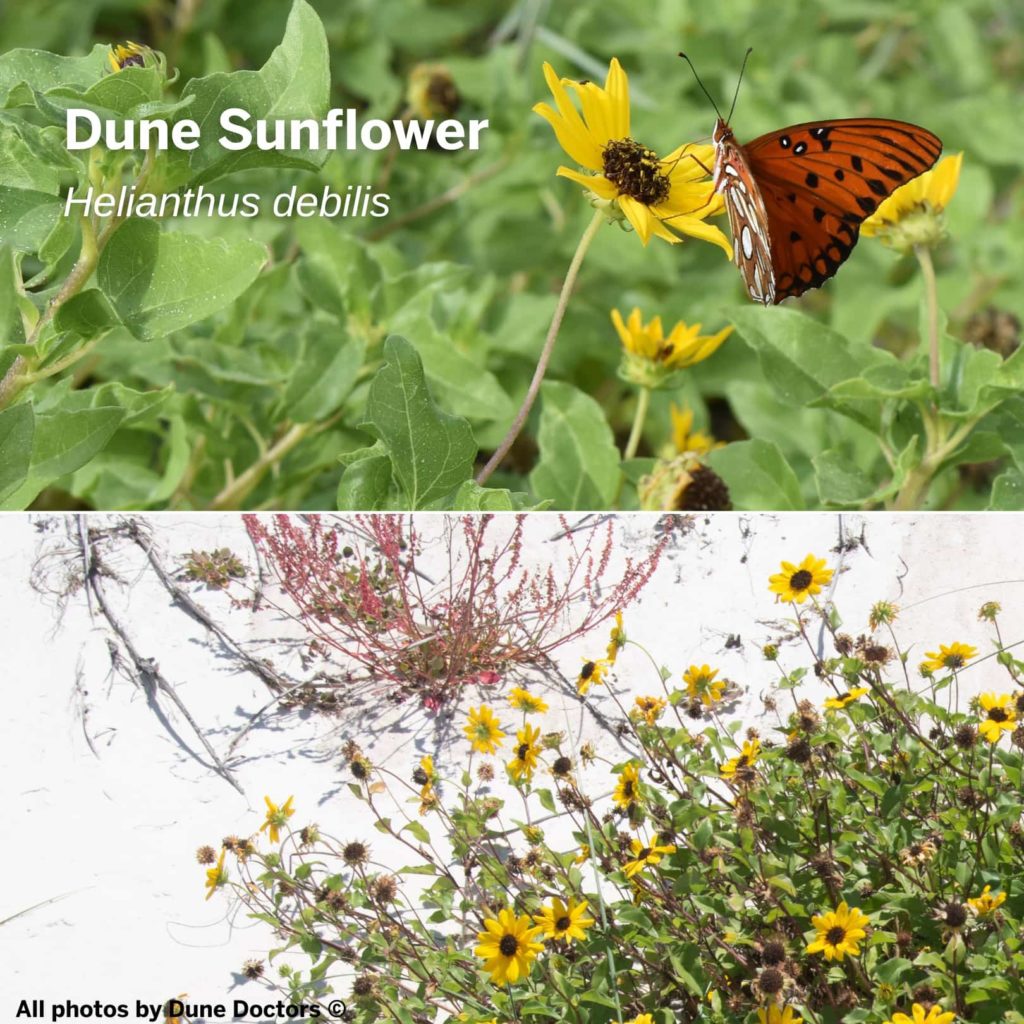
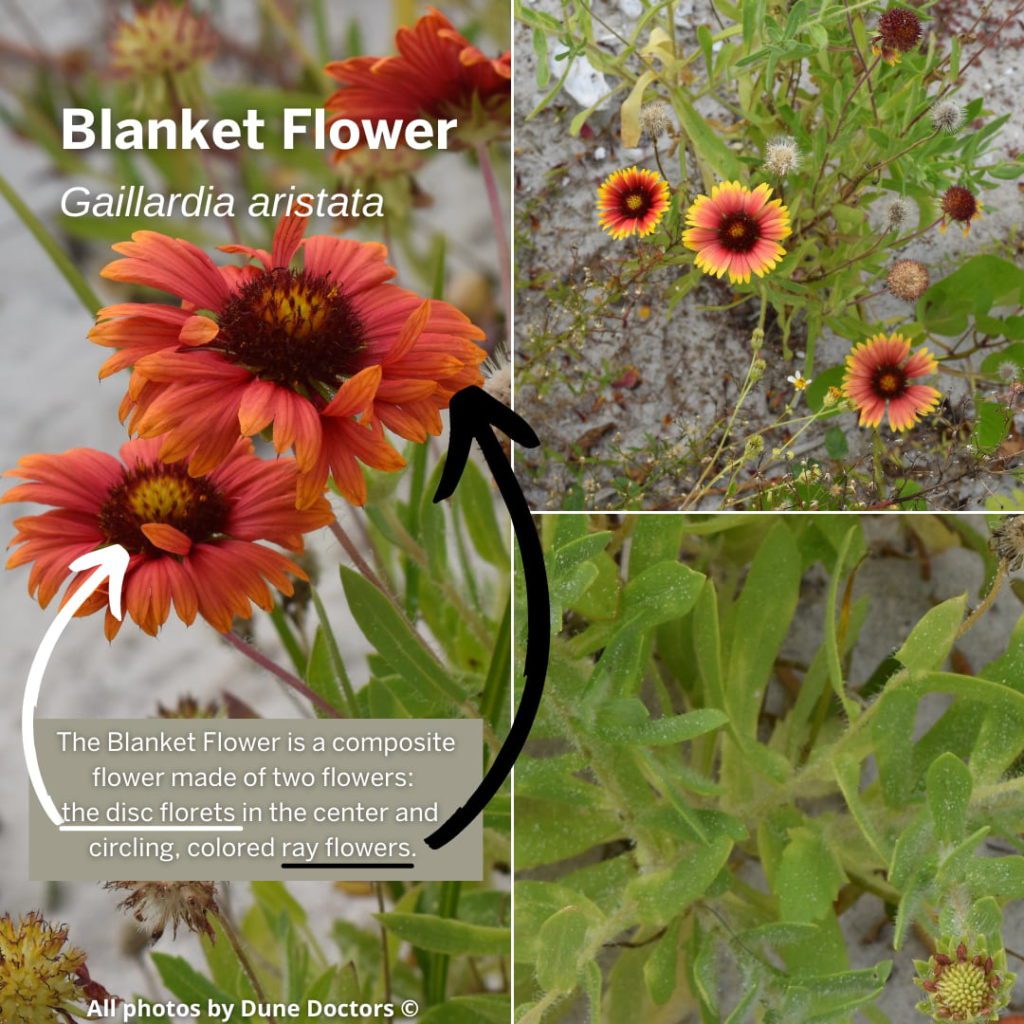
Dune Sunflowers and Indian Blanket Flowers are part of the aster family because their flowers are composite. Composite flowers produce two kinds of flowers: tightly packed brown disc flowers that make up the “eye” of the flower and enlarged ray flowers that function as petals! These brightly-colored composite flowers attract pollinators, and the plants’ tendency to grow in dense patches provides shelter for dune wildlife. These plants are highly salt-tolerant and can grow on the primary dune. While they play a minor role in dune-stabilization, they are critical to the native dune wildlife.
How Dune Doctors Selects the Native Vegetation for our Restoration Projects
When strategically initiating or stabilizing a coastal dune, Dune Doctors uses a variety of plants with different characteristics that each fulfill a specific role. Our team considers the ecological and human-oriented functions such as erosion control, stabilization, and aesthetic enhancement. The Florida Sea Grant Fund and the University of Florida demonstrated that the geographic source of the dune-stabilizing vegetation was a significant factor in the plants’ survival rate when planted in a different location. Therefore, to increase survival rates and protect native ecosystems, Dune Doctors works with regional vegetation coevolved with the environment undergoing restoration.
The dune’s vegetation is the primary natural force limiting sand movement and countering erosion. Because dune systems play a critical role in protecting waterfront communities from destructive wave actions, governmental authorities protect dune-stabilizing native plants on local, state, and federal levels. In all cases, Dune Doctors strives to restore the protective dune environment by using hybrid strategies that pair native vegetation with other construction efforts like sand fencing and sand placement.
Our team of Coastal Restoration Experts can help you obtain proper permitting and implement all restoration efforts on your behalf. Speak with us today at 866-386-6767.
References and Additional Resources:
1. Barnett, Michael R., and David W. Crewz. Common Coastal Plants in Florida: A Guide to Planting and Maintenance. University Press of Florida, 1997.
2. Brown, Stephen. “Helianthus Debilis Family: Asteraceae – Blogs.ifas.ufl.edu.” Ufl.edu, University of Florida, https://blogs.ifas.ufl.edu/leeco/files/2017/05/lee-county-beach_dune_sunflower_Helianthus_debilis.pdf.
3. Hazell, Joy, et al. Sea Oats Uniola Paniculata. University of Florida , https://files1.revize.com/revize/capecoralfl/document_center/Sea_Oats.pdf.
4. Miller, Debbie. Dune Restoration and Enhancement for the Florida Panhandle. University of Florida, https://edis.ifas.ufl.edu/pdf%5CSG%5CSG15600.pdf.
5. Rodriguez, R., Henson, J., Van Volkenburgh, E. et al. Stress tolerance in plants via habitat-adapted symbiosis. ISME J 2, 404–416 (2008). https://doi.org/10.1038/ismej.2007.106
6. “S.C. Sea Grant Consortium.” Scseagrant.org, S.C. Sea Grant Consortium, 2015, https://www.scseagrant.org/wp-content/uploads/Spartina-large-portrait-poster.pdf.
7. Setladge, Sharon. “Advancing Sea Oat Biology .” North Carolina Sea Grant Coast Watch, 28 Nov. 2017, https://ncseagrant.ncsu.edu/coastwatch/previous-issues/2012-2/spring-2012/advancing-sea-oat-biology-advancing-dunes/.
8. Stevenson, Carrie, and Posted: “Weekly ‘What Is It?”: Sea Oats.” UF/IFAS Extension Escambia County, University of Florida, 12 Feb. 2021, http://blogs.ifas.ufl.edu/escambiaco/2020/10/21/weekly-what-is-it-sea-oats/.
9. Williams, M.J. “Native Plants for Coastal Dune Restoration – NRCS.” Arcs.usda.gov, USDA Natural Resources Conservation Services, 2007, https://www.nrcs.usda.gov/Internet/FSE_DOCUMENTS/nrcs141p2_014913.pdf.
10. Witherington, Blair. Florida’s Living Beaches: A Guide for the Curious Beachcomber. 2nd ed., Pineapple Press.
